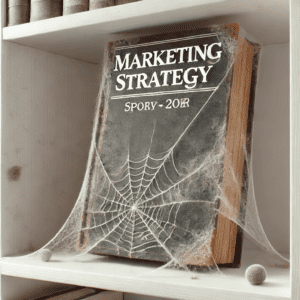The Wake-Up Call You Can’t Afford to Ignore
You’ve poured your heart and soul into this business. Late nights, tough calls, and relentless drive have brought you this far. But lately, something’s off. The numbers that once excited you now keep you up at night. That nagging feeling in your gut? It’s trying to tell you something. What if the very strategy you’ve relied on to connect with customers and fuel growth is now working against you? When was the last time you scrutinized your business marketing strategy with the same intensity you apply to your product development or sales targets?
This isn’t about tweaking a campaign or jumping on the latest trend. It’s about uncovering the hidden flaws that could be silently eroding everything you’ve built.
Ready for some hard truths? Let’s analyze the seven often-overlooked warning signs that your marketing strategy needs an urgent overhaul. These aren’t surface-level issues—they cut to the core of your business’s future.
If you’re ready to realign your marketing with your vision and unlock the growth you know is possible, lean in. It’s time to turn that pit in your stomach into your next breakthrough.
1. Your Brand’s Voice Has Lost its Mojo

Is your brand’s voice resonating in the market and with clients?
Remember when you first started? That fire in your belly, the clear vision of what you wanted to achieve? Now take a hard look at your recent marketing materials. Do they still carry that same passion, that unmistakable “you-ness” that set you apart?
If you’re wincing right now, you’re not alone. It’s easy to lose your voice in the noise of day-to-day operations. But here’s the kicker: your customers can feel it too. That disconnect? It’s costing you more than you know. If your brand was a person at a networking event, would it be the thought leader everyone gravitates towards, or the wallflower struggling to make small talk?
Do you even know who you need to talk to? Understanding your client persona is crucial. If your messaging is off, it’s likely because you haven’t clearly defined who your ideal customer is. Are you speaking directly to their needs, desires, and pain points?
Are you telling a consistent story? Your brand voice should be unmistakable across all platforms. If your social media, website, and marketing materials sound like they’re coming from different companies, you’re confusing your audience and diluting your brand.
Are you communicating your unique value? What sets you apart from the competition? If you can’t articulate this clearly and consistently, neither can your customers. Your unique value proposition should be at the heart of all your communications.
Your Move:
- Define Your Brand Ideal Persona: Create detailed profiles of your ideal customers, including their demographics, psychographics, and pain points. Use these profiles to tailor your messaging.
- Audit Your Brand Voice: Review all your communication channels to ensure consistency. This includes your website, social media, email campaigns, and any other customer touchpoints.
- Craft a Brand Voice Guide: Develop a comprehensive guide that outlines your brand’s tone, style, and key messaging points. Share this guide with your entire team to ensure everyone is on the same page.
- Engage With Your Audience: Regularly interact with your customers on social media and other platforms to understand their needs and preferences better. Use this feedback to refine your messaging.
- Tell Your Story: Ensure that every piece of content you create tells a part of your brand’s story. This story should resonate with your audience and reflect your core values and mission.
2. The Competition Is Eating Your Lunch
Are competitors gaining ground while you’re standing still?
Remember when you were the talk of the industry? When your innovations had competitors scrambling to keep up? Now be honest with yourself. Are you still leading the charge, or are you watching others zoom past you in the rearview mirror?
Market share isn’t just a number. It’s a reflection of your relevance, and your ability to meet evolving customer needs. Every percentage point you lose is a customer choosing someone else’s story over yours.
Your Move:
- Conduct a Competitive Analysis: Identify your main competitors and analyze their strengths and weaknesses. Understand what they are doing differently and why it’s working.
- Identify Market Gaps: Look for unmet needs in the market that your competitors are not addressing. This could be a new product feature, a different pricing strategy, or a unique customer service approach.
- Strengthen Your Value Proposition: Clearly articulate what makes your product or service unique and why customers should choose you over the competition. Ensure this value proposition is communicated consistently across all marketing channels.
- Engage with Your Customers: Regularly seek feedback from your customers to understand their evolving needs and preferences. Use this feedback to make informed decisions about your product and marketing strategies.
- Innovate Continuously: Foster a culture of innovation within your company. Encourage and incentivize your team to come up with new ideas and test them quickly. Stay ahead of trends and be willing to pivot when necessary.
3. Your Customer Acquisition Is a Money Pit

Is your growth coming at an unsustainable price?
Growth feels good, doesn’t it? But at what cost? If you’re spending more to acquire customers than they’re worth over their lifetime, you’re not scaling—you’re sinking.
This isn’t just about tightening the budget. It’s about the fundamental value you offer and how efficiently you’re communicating it. Are you attracting the right customers or just the easy ones?
Your Move:
- Analyze Customer Acquisition Costs (CAC): Calculate your CAC and compare it to the lifetime value (LTV) of your customers. Ensure that your CAC is sustainable and provides a healthy return on investment.
- Segment Your Customers: Identify your most profitable customer segments and focus your marketing efforts on attracting more of these high-value customers.
- Optimize Your Marketing Channels: Evaluate the performance of your marketing channels and allocate your budget to the most effective ones. Consider using a mix of inbound and outbound marketing strategies.
- Enhance Customer Retention: Implement strategies to improve customer retention, such as loyalty programs, personalized marketing, and excellent customer service. Retaining existing customers is often more cost-effective than acquiring new ones.
- Refine Your Messaging: Ensure that your marketing messages clearly communicate the value of your product or service. Highlight the benefits that resonate most with your target audience.
4. You’re Flying Blind in a Data-Rich World
Are gut feelings driving your marketing decisions?
Intuition has its place. It’s probably what got you started in the first place. But in an ever more complex environment, relying solely on instinct is like navigating a storm without instruments. You might get lucky, but the odds aren’t in your favor.
Every decision you make based on “feeling” alone is a missed opportunity to leverage the wealth of data at your fingertips. Your competitors are using data to outsmart, not just outspend, you.
Your Move:
- Invest in Analytics Tools: Choose analytics tools that provide actionable insights into your marketing performance. Many powerful tools like Google Analytics and Power BI offer free versions that can be incredibly effective.
- Train Your Team: Ensure that your team is proficient in using these tools and interpreting the data. Consider hiring a data analyst if needed.
- Set Clear KPIs: Define key performance indicators (KPIs) that align with your business goals. Regularly track and analyze these KPIs to measure the effectiveness of your marketing efforts.
- Create Data-Driven Campaigns: Use the insights from your data to create targeted marketing campaigns. Personalize your messaging based on customer behavior and preferences.
5. Your Marketing and Sales Teams Are Playing Tug-of-War

Is your marketing team operating in a silo?
Picture this: Your marketing team is celebrating a campaign’s “success” with record-breaking leads. Meanwhile, your sales team is drowning in unqualified prospects, unable to close. Sound familiar?
When marketing and sales are out of sync, it’s not just inefficient—it’s destructive. You’re essentially paying one team to make the other’s job harder. And caught in the crossfire? Your bottom line.
Your Move:
- Foster Collaboration: Encourage regular communication and collaboration between your marketing and sales teams. Hold joint meetings to discuss goals, strategies, and challenges. Get a facilitator to help you make sure that you break silos and barriers and have the whole team focus on the customer journey and experience.
- Define Shared Goals: Set common goals and KPIs that both teams are accountable for. This ensures that both teams are working towards the same objectives.
- Implement a Lead Scoring System: Develop a lead scoring system to prioritize leads based on their likelihood to convert. This helps the sales team focus on high-quality leads.
- Create a Feedback Loop: Establish a feedback loop where the sales team provides insights on lead quality and customer interactions. Use this feedback to refine your marketing strategies.
- Align Messaging and Client Experience: Ensure that your marketing, sales, and customer support teams are using consistent messaging throughout the customer journey. This creates a seamless experience for your prospects.
6. You’re Hooked on the Quick-Fix Marketing Drug

Are you sacrificing long-term growth for quick wins?
Flash sales, aggressive discounts, flood-the-market advertising. They feel good in the moment, don’t they? The instant spike in sales, the flood of new customers. But what happens when the dust settles?
If your strategy relies heavily on these quick hits, you’re building your business on quicksand. You’re training customers to wait for discounts, eroding your brand value, and setting yourself up for a never-ending cycle of diminishing returns.
Your Move:
- Develop a Long-Term Strategy: Create a comprehensive marketing plan that balances short-term tactics with long-term goals. Focus on building brand equity and customer loyalty.
- Invest in Content Marketing: Produce high-quality content that educates, entertains, and inspires your audience. This builds trust and positions your brand as an authority in your industry.
- Enhance Customer Experience: Focus on delivering exceptional customer experiences at every touchpoint. Happy customers are more likely to become loyal advocates for your brand.
- Build a Community: Foster a sense of community among your customers through social media, forums, and events. Engaged customers are more likely to stick around and refer others.
- Measure Long-Term Success: Track metrics that reflect long-term success, such as customer lifetime value, brand awareness, and customer satisfaction. Use these metrics to guide your strategy.
7. Your Strategy Is Collecting Cobwebs

Is your marketing strategy stuck in the past?
The world has changed. Has your marketing strategy kept pace? If your approach hasn’t fundamentally evolved in the past few years, you’re not just behind—you’re quickly becoming irrelevant.
This isn’t about chasing every shiny new trend. It’s about deeply understanding how your customers’ worlds have changed and adapting to meet them where they are now, not where they were when you started.
Your Move:
- Conduct Market Research: Regularly conduct market research to understand changing customer behaviors, preferences, and trends. Use this information to inform your strategy.
- Stay Agile: Adopt an agile marketing approach that allows you to quickly test and implement new ideas. Be willing to pivot when necessary.
- Embrace Digital Transformation: Leverage digital tools and technologies to enhance your marketing efforts. This includes social media, email marketing, SEO, and marketing automation.
- Innovate Continuously: Encourage a culture of innovation within your team. Regularly brainstorm new ideas and experiment with different approaches.
- Monitor Competitors: Keep an eye on your competitors and learn from their successes and failures. Use this knowledge to stay ahead of the curve.
It’s Time to Rewrite Your Marketing Playbook
Recognizing these warning signs is just the beginning. The real test? Having the courage to act on them. Every challenge we’ve discussed is also an opportunity—a chance to reinvent, to leap ahead while others hesitate.
Remember why you started this journey. The vision you had, the problems you wanted to solve, the lives you wanted to improve. That purpose is still your greatest asset. Let it guide you as you realign your marketing strategy with the current reality and future possibilities.
This isn’t about incremental changes. It’s about bold moves that redefine the game. Are you ready to turn these insights into action? Your next chapter of growth is waiting to be written. The pen is in your hand.
Ready to Reboot Your Marketing Strategy?
You’ve just identified the symptoms. Now it’s time for a thorough diagnosis and a custom-tailored treatment plan. At Mikesell Digital Consulting, we don’t just offer advice—we provide a robust framework, cutting-edge diagnostics, and a proven process to craft and implement growth-focused marketing strategies.
Don’t let another day go by watching your potential slip away. It’s time to turn those red flags into green lights for growth.
Take the first step towards transforming your marketing strategy. Schedule a no-obligation strategy session with our team of experts. We’ll dive deep into your unique challenges, uncover hidden opportunities, and show you exactly how we can help you craft a marketing strategy that doesn’t just keep up—it sets the pace.
Contact us now or click here to book your strategy session. Let’s rewrite your marketing story—together.
Remember, in the world of business, standing still is moving backwards. Take action now before your competition does.
References:
- Bain & Company. (2023). Brand Strategy Consulting. Retrieved from Bain & Company
- Kim W. C. & Mauborgne R. (2015). Blue Ocean Strategy: How to Create Uncontested Market Space and Make the Competition Irrelevant. Harvard Business Review Press.
- Dib A. (2016). The 1-Page Marketing Plan: Get New Customers, Make More Money, And Stand out From The Crowd. Successwise.
- Kingsnorth S. (2019). Digital Marketing Strategy: An Integrated Approach to Online Marketing. Kogan Page.
- Eiler T. & Austin A. (2016). Aligned to Achieve: How to Unite Your Sales and Marketing Teams into a Single Force for Growth. Wiley.
- Ellis S. & Brown M. (2017). Hacking Growth: How Today’s Fastest-Growing Companies Drive Breakout Success. Crown Business.
- Kotler P., Kartajaya H., & Setiawan I. (2017). Marketing 4.0: Moving from Traditional to Digital. Wiley.







